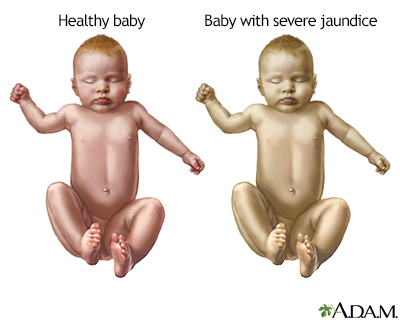Exchange transfusion
Hemolytic disease - exchange transfusionExchange transfusion is a potentially life-saving procedure that is done to counteract the effects of serious jaundice or changes in the blood due to diseases such as sickle cell anemia.
The procedure involves slowly removing the person's blood and replacing it with fresh donor blood or plasma.
Description
An exchange transfusion requires that the person's blood be removed and replaced. In most cases, this involves placing one or more thin tubes, called catheters, into a blood vessel. The exchange transfusion is done in cycles, each one most often lasts a few minutes.
The person's blood is slowly withdrawn (most often about 5 to 20 mL at a time, depending on the person's size and the severity of illness). An equal amount of fresh, prewarmed blood or plasma flows into the person's body. This cycle is repeated until the correct volume of blood has been replaced.
After the exchange transfusion, catheters may be left in place in case the procedure needs to be repeated.
In diseases such as sickle cell anemia, blood is removed and replaced with donor blood.
In conditions such as neonatal polycythemia, a specific amount of the child's blood is removed and replaced with a normal saline solution, plasma (the clear liquid part of blood), or albumin (a normal blood protein). This decreases the total number of red blood cells in the body and makes it easier for blood to flow through the body.
Neonatal polycythemia
Polycythemia means there are too many red blood cells (RBCs) in an infant's blood.

Why the Procedure Is Performed
An exchange transfusion may be needed to treat the following conditions:
- Dangerously high red blood cell count in a newborn (neonatal polycythemia)
- Rh-induced hemolytic disease of the newborn
- Severe disturbances in body chemistry
- Severe newborn jaundice that does not respond to phototherapy with bili lights
Phototherapy with bili lights
Bili lights are a type of light therapy (phototherapy) that is used to treat newborn jaundice. Jaundice is a yellow coloring of the skin and eyes. ...
 ImageRead Article Now Book Mark Article
ImageRead Article Now Book Mark Article - Severe sickle cell crisis
- Toxic effects of certain drugs
Risks
General risks are the same as with any transfusion. Other possible complications include:
- Blood clots
- Changes in blood chemistry (high or low potassium, low calcium, low glucose, change in acid-base balance in the blood)
- Heart and lung problems
- Infection (very low risk due to careful screening of blood)
- Shock if not enough blood is replaced
After the Procedure
The person may need to be monitored for several days in the hospital after the transfusion. The length of stay depends on what condition the exchange transfusion was performed to treat.
References
Golden WC, Watchko JF. Neonatal hyperbilirubinemia and kernicterus. In: Gleason CA, Sawyer T, eds. Avery's Diseases of the Newborn. 11th ed. Philadelphia, PA: Elsevier; 2024:chap 72.
Kliegman RM, St. Geme JW, Blum NJ, Shah SS, Tasker RC, Wilson KM. Blood disorders. In: Kliegman RM, St. Geme JW, Blum NJ, Shah SS, Tasker RC, Wilson KM, eds. Nelson Textbook of Pediatrics. 21st ed. Philadelphia, PA: Elsevier; 2020:chap 124.
Park J. Hematology. In: Anderson CC, Kapoor S, Mark TE, eds. Harriet Lane Handbook, The: The Johns Hopkins Hospital. 23rd ed. Philadelphia, PA: Elsevier; 2021:chap 14.
Rodrigue BB, Sloan SR. Pediatric transfusion medicine. In: Hoffman R, Benz EJ, Silberstein LE, et al, eds. Hematology: Basic Principles and Practice. 8th ed. Philadelphia, PA: Elsevier; 2023:chap 119.
Review Date: 11/6/2023
Reviewed By: Neil K. Kaneshiro, MD, MHA, Clinical Professor of Pediatrics, University of Washington School of Medicine, Seattle, WA. Also reviewed by David C. Dugdale, MD, Medical Director, Brenda Conaway, Editorial Director, and the A.D.A.M. Editorial team.





